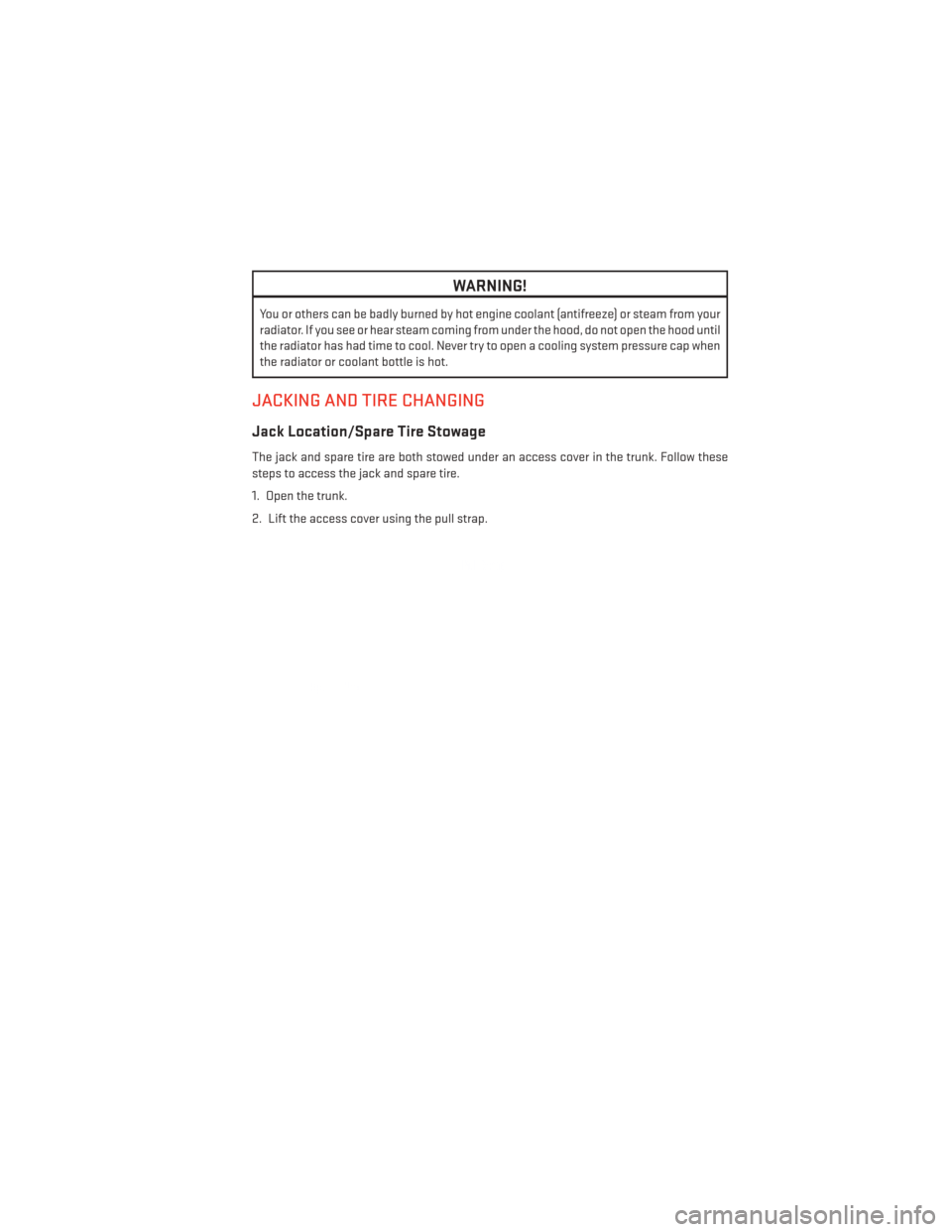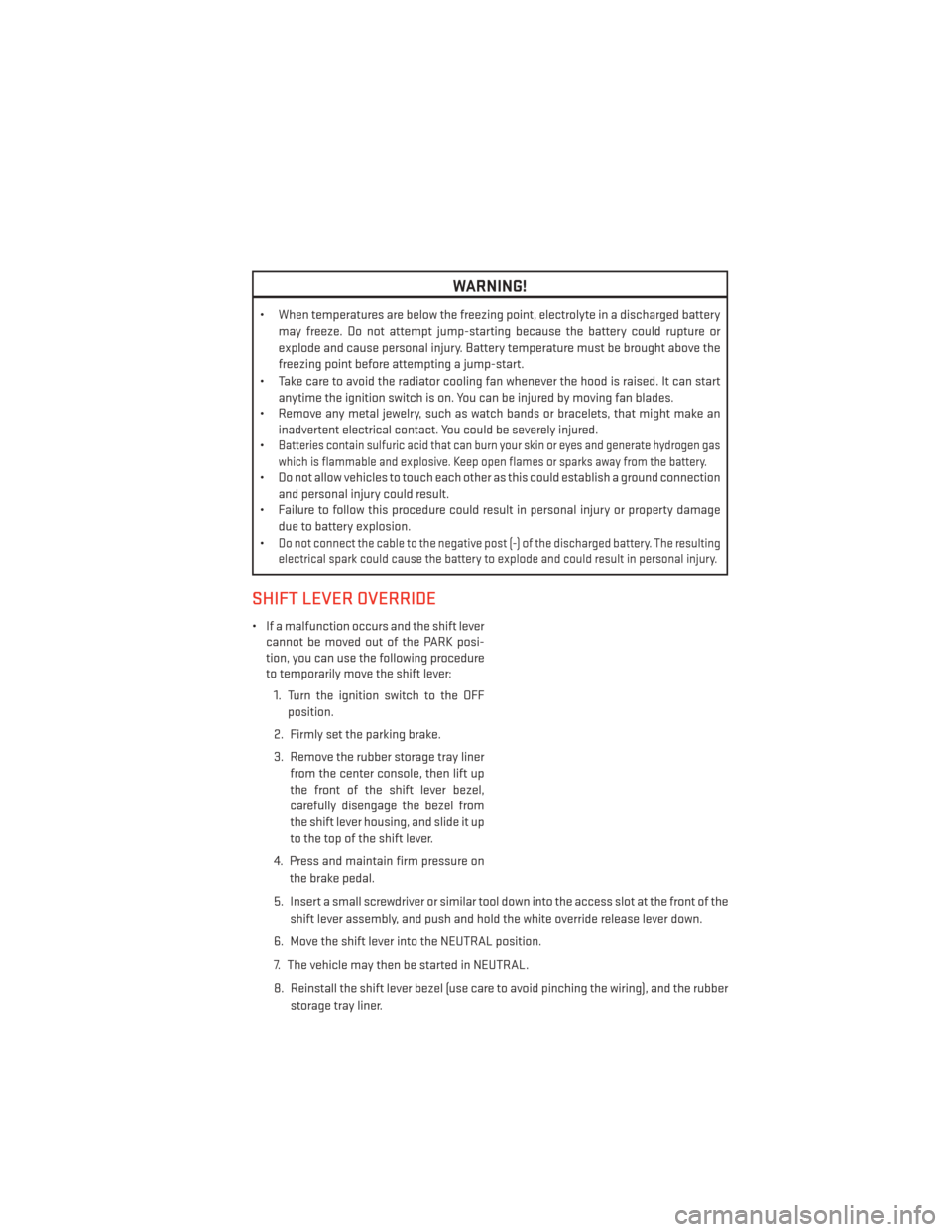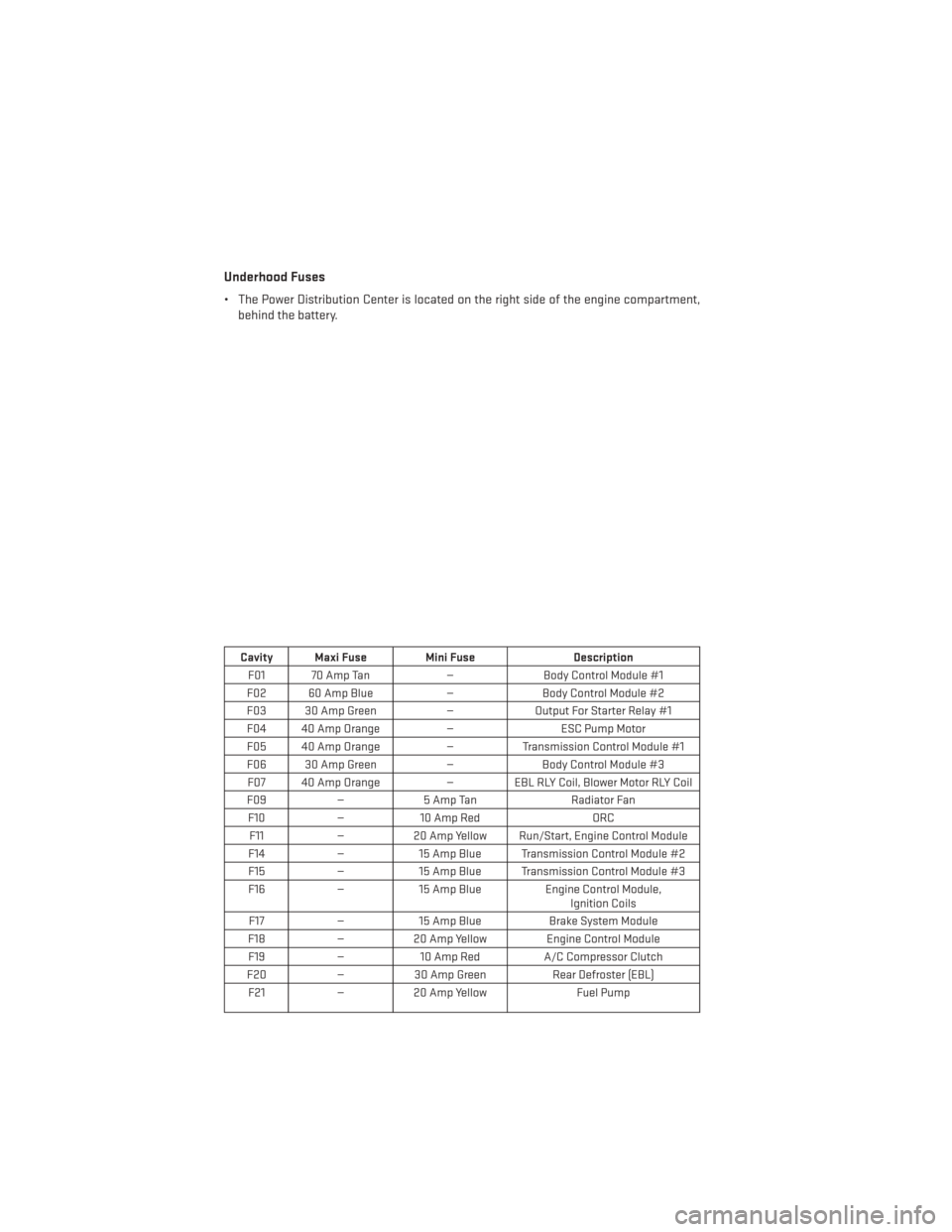radiator DODGE DART 2014 PF / 1.G User Guide
[x] Cancel search | Manufacturer: DODGE, Model Year: 2014, Model line: DART, Model: DODGE DART 2014 PF / 1.GPages: 140, PDF Size: 4.57 MB
Page 90 of 140

• Press and hold the RIGHTarrow button for one second to access the ”Oil Life Reset”
screen.
• Press and hold the DOWN
arrow button until the screen shows 100% oil life.
• Press and release the Up arrow button to exit the EVIC screen.
NOTE:
If the indicator message illuminates when you start the vehicle, the oil change indicator
system did not reset. If necessary, repeat this procedure.
IF YOUR ENGINE OVERHEATS
• In any of the following situations, you can reduce the potential for overheating by taking the appropriate action.
• On the highways — slow down.
• In city traffic — while stopped, place the transmission in NEUTRAL, but do not increase engine idle speed.
NOTE:
There are steps that you can take to slow down an impending overheat condition:
• If your air conditioner (A/C) is on, turn it off. The A/C system adds heat to the engine cooling system and turning the A/C off can help remove this heat.
• You can also turn the temperature control to maximum heat, the mode control to floor and the blower control to high. This allows the heater core to act as a supplement to the
radiator and aids in removing heat from the engine cooling system.
CAUTION!
Vehicles with base cluster
• Driving with a hot cooling system could damage your vehicle. If the temperature gauge reads H (hot), pull over and stop the vehicle. Idle the vehicle with the air
conditioner turned off until the pointer drops back into the normal range. If the
pointer remains on H (hot), turn the engine off immediately and call for service.
Vehicles with premium cluster
• Driving with a hot cooling system could damage your vehicle. If the temperature gauge reads 240°F (116 °C) or greater pull over and stop the vehicle. Idle the vehicle
with the air conditioner turned off until the pointer drops back into the normal range
200–230°F (93–110°C). If the pointer remains at 240°F (116°C) or greater and you hear
a chime, turn the engine off immediately and call for service.
WHAT TO DO IN EMERGENCIES
88
Page 91 of 140

WARNING!
You or others can be badly burned by hot engine coolant (antifreeze) or steam from your
radiator. If you see or hear steam coming from under the hood, do not open the hood until
the radiator has had time to cool. Never try to open a cooling system pressure cap when
the radiator or coolant bottle is hot.
JACKING AND TIRE CHANGING
Jack Location/Spare Tire Stowage
The jack and spare tire are both stowed under an access cover in the trunk. Follow these
steps to access the jack and spare tire.
1. Open the trunk.
2. Lift the access cover using the pull strap.
WHAT TO DO IN EMERGENCIES
89
Page 105 of 140

WARNING!
• When temperatures are below the freezing point, electrolyte in a discharged batterymay freeze. Do not attempt jump-starting because the battery could rupture or
explode and cause personal injury. Battery temperature must be brought above the
freezing point before attempting a jump-start.
• Take care to avoid the radiator cooling fan whenever the hood is raised. It can start anytime the ignition switch is on. You can be injured by moving fan blades.
• Remove any metal jewelry, such as watch bands or bracelets, that might make an
inadvertent electrical contact. You could be severely injured.
•
Batteries contain sulfuric acid that can burn your skin or eyes and generate hydrogen gas
which is flammable and explosive. Keep open flames or sparks away from the battery.
• Do not allow vehicles to touch each other as this could establish a ground connection
and personal injury could result.
• Failure to follow this procedure could result in personal injury or property damage
due to battery explosion.
•
Do not connect the cable to the negative post (-) of the discharged battery. The resulting
electrical spark could cause the battery to explode and could result in personal injury.
SHIFT LEVER OVERRIDE
• If a malfunction occurs and the shift lever cannot be moved out of the PARK posi-
tion, you can use the following procedure
to temporarily move the shift lever:
1. Turn the ignition switch to the OFF position.
2. Firmly set the parking brake.
3. Remove the rubber storage tray liner from the center console, then lift up
the front of the shift lever bezel,
carefully disengage the bezel from
the shift lever housing, and slide it up
to the top of the shift lever.
4. Press and maintain firm pressure on the brake pedal.
5. Insert a small screwdriver or similar tool down into the access slot at the front of the shift lever assembly, and push and hold the white override release lever down.
6. Move the shift lever into the NEUTRAL position.
7. The vehicle may then be started in NEUTRAL.
8. Reinstall the shift lever bezel (use care to avoid pinching the wiring), and the rubber storage tray liner.
WHAT TO DO IN EMERGENCIES
103
Page 114 of 140
![DODGE DART 2014 PF / 1.G User Guide ComponentFluid, Lubricant, or Genuine
Part Capacities
Spark Plugs 2.0L Engine We recommend you use MOPAR® Spark Plugs
(Gap 0.043 in [1.1 mm]) —
Spark Plugs 2.4L Engine We recommend you use MOPAR® DODGE DART 2014 PF / 1.G User Guide ComponentFluid, Lubricant, or Genuine
Part Capacities
Spark Plugs 2.0L Engine We recommend you use MOPAR® Spark Plugs
(Gap 0.043 in [1.1 mm]) —
Spark Plugs 2.4L Engine We recommend you use MOPAR®](/img/12/5599/w960_5599-113.png)
ComponentFluid, Lubricant, or Genuine
Part Capacities
Spark Plugs 2.0L Engine We recommend you use MOPAR® Spark Plugs
(Gap 0.043 in [1.1 mm]) —
Spark Plugs 2.4L Engine We recommend you use MOPAR® Spark Plugs
(Gap 0.047 in [1.2 mm]) —
Automatic Transmission –
1.4L Turbo Engine We recommend you use
MOPAR® C635 DDCT/MTX
Transmission Fluid. —
Automatic Transmission –
2.0L, 2.4L Engine We recommend you use
SK Energy ATF SP-4 Trans-
mission Fluid. —
Manual Transmission We recommend you use MOPAR® C635 DDCT/MTX
Transmission Fluid. —
Brake Master Cylinder We recommend you use MOPAR® DOT 3 SAE J1703.
If DOT 3 is not available, then
DOT 4 is acceptable. Only use
recommended brake fluids. —
CAUTION!
• Mixing of engine coolant (antifreeze) other than specified Organic Additive Technol-
ogy (OAT) engine coolant (antifreeze), may result in engine damage and may de-
crease corrosion protection. Organic Additive Technology (OAT) engine coolant is
different and should not be mixed with Hybrid Organic Additive Technology (HOAT)
engine coolant (antifreeze) or any “globally compatible” coolant (antifreeze). If a
non-OAT engine coolant (antifreeze) is introduced into the cooling system in an
emergency, the cooling system will need to be drained, flushed, and refilled with
fresh OAT coolant (conforming to MS-12106), by an authorized dealer as soon as
possible.
• Do not use water alone or alcohol-based engine coolant (antifreeze) products. Do not
use additional rust inhibitors or antirust products, as they may not be compatible
with the radiator engine coolant and may plug the radiator.
• This vehicle has not been designed for use with propylene glycol-based engine
coolant (antifreeze). Use of propylene glycol-based engine coolant (antifreeze) is not
recommended.
MAINTAINING YOUR VEHICLE
112
Page 120 of 140

Underhood Fuses
• The Power Distribution Center is located on the right side of the engine compartment,behind the battery.
Cavity Maxi Fuse Mini Fuse Description
F01 70 Amp Tan —Body Control Module #1
F02 60 Amp Blue —Body Control Module #2
F03 30 Amp Green —Output For Starter Relay #1
F04 40 Amp Orange —ESC Pump Motor
F05 40 Amp Orange —Transmission Control Module #1
F06 30 Amp Green —Body Control Module #3
F07 40 Amp Orange — EBL RLY Coil, Blower Motor RLY Coil
F09 —5 Amp Tan Radiator Fan
F10 —10 Amp Red ORC
F11 —20 Amp Yellow Run/Start, Engine Control Module
F14 —15 Amp Blue Transmission Control Module #2
F15 —15 Amp Blue Transmission Control Module #3
F16 —15 Amp Blue Engine Control Module,
Ignition Coils
F17 —15 Amp Blue Brake System Module
F18 —20 Amp Yellow Engine Control Module
F19 —10 Amp Red A/C Compressor Clutch
F20 —30 Amp Green Rear Defroster (EBL)
F21 —20 Amp Yellow Fuel Pump
MAINTAINING YOUR VEHICLE
118